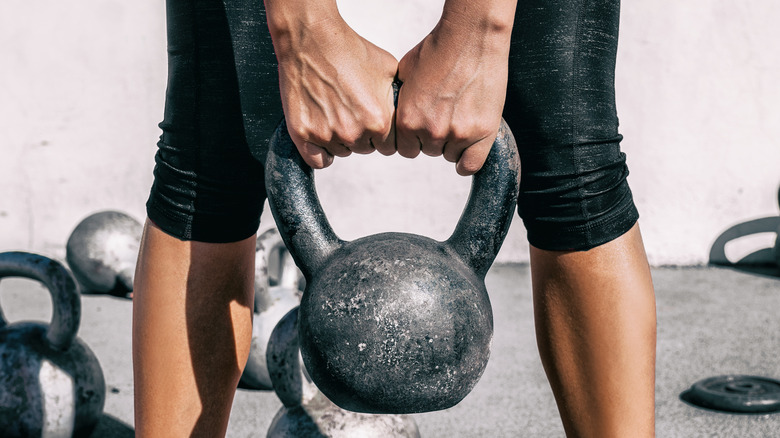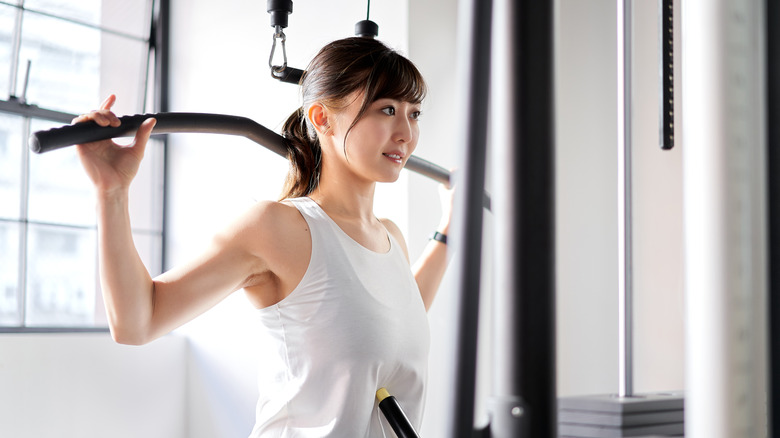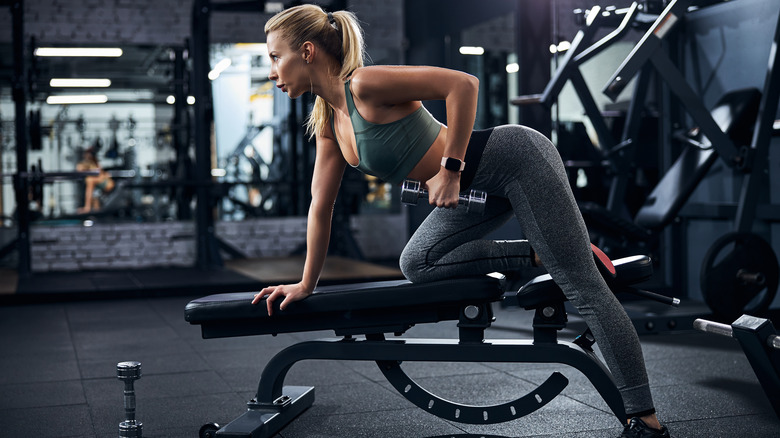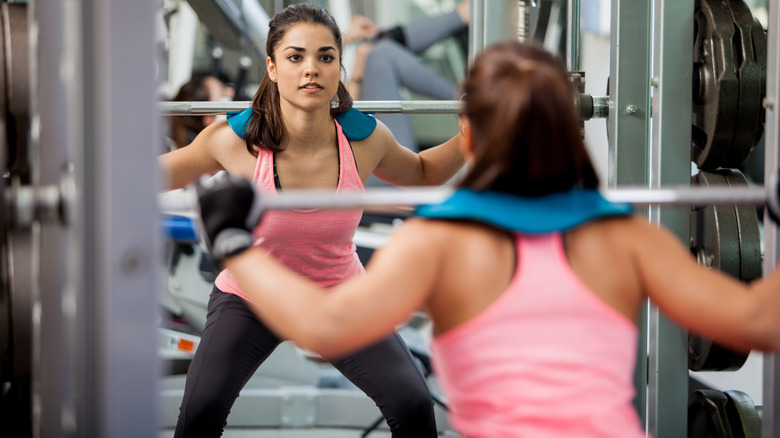Should You Be Sticking To Machines Or Free Weights In The Gym?
Lifting weights isn't just for bodybuilders or Brie Larson prepping to play Captain Marvel (via Fit and Well). Pretty much everyone can benefit from strength training of some kind. Strength training is all about building lean muscle in a way that you can't build it while doing cardio (via Self). What makes strength training so great is that it doesn't just give you toned and strong muscles. It also helps your heart health, it strengthens your bones, and it boosts your metabolism, which means you burn more calories throughout the day even when you're not working out (per Healthline).
You might not be able to afford to hire a personal trainer, as Larson and many other celebrities do when prepping for a hardcore role. And if you're new to the gym or you're wanting to add some strength training to your workout routine for the first time, it can be intimidating to know where to start with all of the equipment. Many gyms come equipped with free weights, like dumbbells, barbells, and kettlebells (so many bells!), and various weight machines, designed to work different muscles. There's no one best way to work out, so here's what to consider between free weights and machines.
Weight machines are great for isolating muscles
Target is the key word when it comes to weight machines. They are generally designed to focus on one muscle or set of muscles — for instance, just the biceps or your quadriceps (via Boston Magazine). That way, you can move from machine to machine knowing exactly which muscles you're working. Another benefit to using machines is that the machine is set up to specifically guide your range of motion, so it's harder to have sloppy form that could potentially lead to injury (per Very Well Fit).
And if you have some strong muscles that are overcompensating for weak ones, that can plateau your overall athletic gains. Weight machines don't allow for other muscle groups to help out (via humanmovement). That isolation of a muscle group can help with rehabbing an injury as well; certified personal trainer Rain Burkeen gave Self the example of someone with a lower back injury who can't do squats, but could safely use weight machines to keep their leg muscles strong.
Weight machines can be intimidating the first time
One potential barrier to using a weight machine, particularly for the first time, is that it might be tricky to learn how to adjust the amount of weight or to make sure you're doing it correctly, so you might just avoid the machines entirely. But each one should have a diagram for the correct position you should be in and exactly which muscles are being targeted.
There will also likely be adjustments to make on the machine for your height or range of movement; take the time to make sure you're setting up the machine to best work for you. One hack if you're anxious about using a machine for the first time or if it's busy? Take a picture of the diagram that shows how to use the machine with your phone and look it over off to the side or while waiting for your turn (per Very Well Fit).
Free weights use more muscles at the same time
Training with free weights engages more muscles compared to weight machines (via Self). Weight training that utilizes multiple muscle groups are compound exercises; think of a squat that engages the quads, glutes, hamstrings, calves, and core (via Women's Health UK). Or the bench press that makes you use your pecs, shoulders, triceps, and lats (via Bustle). Doing compound exercises allows for more efficient training, which can mean you're in the gym for less time while still strengthening plenty of muscles. Free weights also end up improving your balance and coordination, since you're using stabilizing muscles along with the main muscles that you're targeting (per Shape).
There are more workout variation and options with free weights. You're the one controlling the weight and the speed at which you're lifting. And you can stake out your spot at the gym with your weights and maybe a bench and get through an entire full body workout, instead of having to go from machine to machine (via Women's Health UK).
Focus on your form when using free weights
Free weights are anything in the gym that you can move freely. But just because you can swing a weight around doesn't mean you should. There is some serious injury potential with free weights because of that freedom. A study in Australia (posted at the National Library of Medicine) surveyed people who went to the emergency room after a gym accident and discovered that using free weights caused the most injuries when compared to other types of exercise, including "crushed by falling/dropped weights." (Ouch!)
And since using free weights doesn't have limits the way that weight machines do, you have to pay more attention to your form to avoid getting injured. When in doubt, start with a lighter weight to test your range of motion and how much you can lift to get an injury-free workout. The mirrors at the gym aren't for vanity; use them, especially if you're a beginner, to ensure you have good form when you're using free weights (per Lifehacker).
Be patient when starting strength training
Whichever you decide between free weights or weight machines, remember that adding in weight training to your workout routine should be done gradually and carefully. You will get results if you keep at it, but it could take six to eight weeks (via Women's Health).
You can lift weights every day, but you should change up the parts of your body that you're targeting; alternating between upper and lower body can be a good way to break down your strength workouts. Over-training is a real thing, and just because you're not actively working on that muscle group on a given day, that doesn't mean change isn't happening. Lifting weights causes microscopic tears in the muscle, and your body needs time to repair those tears, which then makes the muscle fibers stronger (via The New York Times). It's that repeat of working the muscles, resting them, then working them again that builds stronger, lean muscle.





